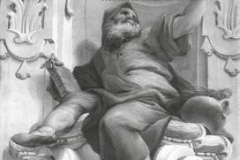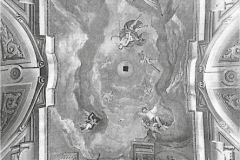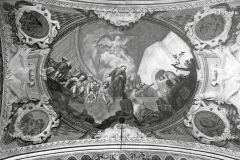Baroque Fresco Painting in Hungary III. – Győr-Moson-Sopron and Vas Counties
MMA Publishing Co. – MÉM-MDK, edited by János Jernyei Kiss, Budapest, 2022
Text: György Szegő
Photos: Academy of Hungarian Arts Publisher
Imposing volumes by MMA/MÉM-MDK survey the Baroque frescoes of Hungary documented with high-resolution photos based on architectural history. The result of more than a decade work carried out at Péter Pázmány Catholic University Drepartment of Art History has been associated with an international research project titled „Baroque Painting in Hungary”. Participants of the latter were the cities of Munich, Regensburg, Erlangen, Bochum, Wroczlaw, Prague, Brno, Vienna, Bratislava, Budapest, Bologna, Verona, Venice, Maribor and Zagreb. The volumes no. I. and II. have been presented in MÉ issues 2020/2 and 2021/1. Similarly imposing, volume No. III. relied on authentic sources such as designs and archive documents, the materials of previous restorations both writings and photographs. As part of the research, today’s technology allows researchers to study details which are difficult to access or very distant, the original painting technique, the earlier conditions and interventions. It is not only the many (previously unseen) detailed photographs included in the volume that are a success, but even more so: the ever-growing digital archives. As in previous research, the inclusion of sections on “Architectural Views, Decorative Painting, Frames” is an important approach. This method allows to bring together the illusionistic designs shared by the architect and the painter. Precise appendices have completed the scholarly approach, but the editor and the authors also hope that their work will reach a wider audience. The primary aim was to create a complete catalogue of Hungarian Baroque fresco painting. The forthcoming Volume No. IV will include Baroque frescoes from the regions around Budapest and northern Hungary, whilst Volume No. V will cover Baroque frescoes from the territory of historical Hungary. The latter, however, requires international cooperation, which is precisely in line with the strategy of the research and book series. The historical scope of the now three-volume work is a big question: do these frescoes have an influence on the art of later periods? Can this art reach the lay public nowadays? Since the wet plaster required for fresco painting demanded unprecedented speed, deft brushwork and speedy work on a scaffold, overhead, on a vaulted ceiling, it gave birth to an unheard fresh imagery, which painters of later periods and present times have valued and integrated into their art as a source of inspiration.


